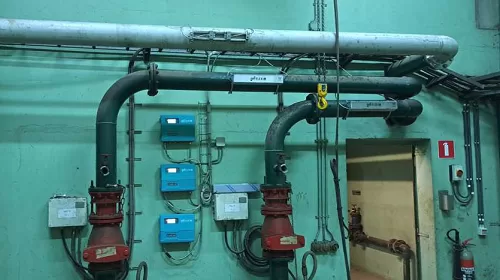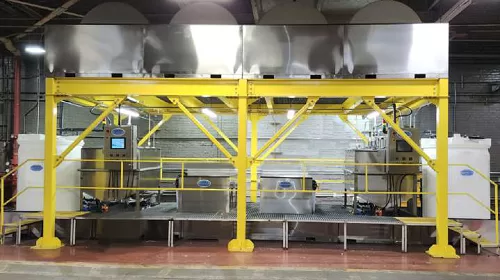HEMALATHA D. S. and SADASHIVA MURTHY B. M.
ABSTRACT
The grey water includes 80–85% of household wastewater. The re-use of this kind of wastewaters is considered as an alternative to the reduction of clean water consumption.The main objective of this dissertation work is to study and design a low cost treatment of grey water and its reuse for non-potable purpose. SJCE Boy’s Hostel of JSS S&TU, Mysuru was selected as suitable site for the present work and collected the grey water samples from four different sources. The physical, chemical and bacteriological characteristics of the raw grey water samples were analysed. Performance of the lab scale filtration system was evaluated and found the treatment efficiency. The lab scale filter was very efficient in reduction of turbidity, total solids, BOD5, phosphate and MPN to about 90%, 63%, 55%, 87% and 61% respectively. A design proposal of a single centralized vertical filter unit and individual filter units for each block was prepared. The treated grey water from the sand and gravel filters can be reused for non-potable use like flushing tanks, gardening, street cleaning and sewer cleaning. It was found that if the treated grey water is reused in the selected site (SJCE Boy’s Hostel), a reductionof about 60 – 75% in use of fresh water can be achieved.
INTRODUCTION
Water once used or utilized in any domestic purpose generates the Domestic wastewater. Grey water and black water are the two streams that make up this residential wastewater. Grey water is typically characterized as water from the shower, bath, washbasin, washing machine, and dishwasher. Black water is the residual bathroom water. 80–85 percent of the wastewater from households is included in the grey water. Reusing these wastewaters is suggested as an alternative to cutting back on the use of clean water. The re-use of treated grey waters is not, however, mandated by law in many nations. On the other hand, as water becomes much scarce, there is a growing interest in this subject. This interest in reuse is further fueled by the low organic matter and pathogen content of grey waters.
SOURCES OF GREY WATER
The main source of grey water at households include the water generated as by-product of processes such as bathing, Cloth washing (laundry),cooking, washing utensils, washing livestock. Whereas, on the other hand, Black water is the wastewater that is contaminated with fecal matter and urine. The components present in the grey water are entirely different from black water. Grey water has only 1/10 of nitrogen found in black water and comparatively less load of pathogens than black water. Therefore, the organic content of grey water gets decomposes rapidly than black water. Thus, the treatment of grey water generated from households is easier. These main factors makes it usable as a sustainable source for irrigation, provided it meets quality criteria.
COMPOSITION OF GREY WATER
The amount of wastewater generated from any household or residential building or institutions mainly depends on number of occupants in the building, their life style, availability of adequate water supply system, quantity of water supplied, water usage pattern, customs, water cost and the climate. Grey water is the wastewater generated in the bathroom, laundry and kitchen. Therefore, grey water is that component of domestic wastewater which does not include the wastewater from the toilet or urinal.
The composition of grey water also vary from place to place and people to people. Living standards of people, social and cultural practices of people and level of water crisis in the region are the main factors that influences the composition of grey water. Other factors on which the composition of grey water depend are type and kind of cleansing agents such as soaps, detergents, shampoos, tooth paste, dish washing agents etc. Huge fluctuation in chemical and microbial quality of grey water occurs depending on the source of generation and type of grey water.
BENEFITS OF GREY WATER TREATMENT
The benefits of grey water treatment are listed below:
• Lowering the fresh water use
• Less load on wastewater treatment plant
• Less energy and chemical use
• Highly Effective Purification
• Protection of Water Resources
• Ground water recharge
• Plant growth
• Reclaiming nutrients that would otherwise be wasted
TREATMENT OF GREY WATER
Grey water requires the least amount of treatment because it is the least contaminated portion of wastewater. Grey water often contains settleable, colloidal, and total suspended solids (TSS) that are larger than 0.2 m. Grey water contains 30 to 40% inorganic solids and 60 to 70% easily degradable organic materials. The majority of the inorganic portion is sand and grit, which collect to create an inorganic sludge. Both settleable and colloidal solids are included in the total suspended solids. One of the simple treatment technique to eliminate suspended particles is by using settling or filtering.
The grey water treatment options are shown in Figure 1 which include anaerobic sludge reactors, septic tanks, oxidation ponds etc.
Among the above mentioned options the filtration was followed in the present dissertation work due to the following advantages:
Simple in operation and upkeep
Economical
Comprehensive physical treatment
Better quality treated water
Use of locally accessible filter media
No external energy source is required.
Filtration is the simple treatment adopted for separating the macro particles present in grey water. Grey water has relatively low nutrient and pathogenic content and therefore it can be easily treated to a high quality water using simple techniques such as sand/gravel filters or using activated charcoal, etc. Figure 2 shows the filtration spectrum for different separation process.
CASE STUDY
Grey water samples from an institutional hostel premises were collected and its physic-chemical characteristics were determined. Performance evaluation of a lab scale sand and gravel filter media for low cost treatment of grey water was carried out for grey water samples. The filtered grey water was proposed to reuse in the flushing tanks of toilets, which may lead to reduction in consumption of fresh water.
The work was carried out for the grey water samples collected from SJCE Boy’s Hostel, JSS Science and Technology University, Mysuru, Karnataka, India. The study area is located at a latitude of 12.3133°N and longitude of 76.6134°E.The aerial view of the study area is shown in Figure3.
The hostel premises comprises of a kitchen and dining hall, three big blocks named as Block1, Block 2 and Block 3 hosting around 650 students, one PG blockhosting 55 students and six guest house blocks hosting around 120 students. The hostel provides the students both boarding and lodging facility. Three number of cloth washing machines were provided for the students at back side of the Block 1. Drinking water facility is provided to the students by installing Reverse Osmosis (RO) units at each individual blocks. Hot water facility for bathing is given by using Solar Water Heaters and Boilers/Geysers.
In the present study, discrete sample, also known as grab sample of grey water viz., bathroom wastewater, Hand Wash Basin Wastewater, Cloth Washing (Machine Washing) wastewater and kitchen wastewater were collected in an individual container separately from four different sampling points. The layout of the study area and location of the four sampling sites chosen for present study are shown in Figure 4. The collected sample was bought to the laboratory and stored in Sample Preservator at 4°C. The physical, chemical and bacteriological characteristics of each grab samples were analyzed separately and the data was tabulated (Table 1). The collected samples were filtered using the lab scale model of filtration system. The lab scale model of filtration system was used to check the efficiency of treating Grey Water samples. The system was square shaped, vertical type filter made of thick glass (acrylic) material. Plate 1 depicts the Lab Scale Filtration System used for treating Grey Water Samples. Filtration treatment was given separately for the four different types of grey water viz., bathroom wastewater, hand-wash basin wastewater, washing machine wastewater, kitchen wastewater. Performance of the filtration system was evaluated keeping the following parameters of concern as reference. It includes Turbidity, Total solids, Chloride, Biochemical oxygen demand (BOD5), Chemical oxygen demand (COD), Phosphate and MPN. The percentage reduction in concentration, parameters of concern in filtered grey water samples are shown in Table 2:
The filtered grey water can be reused for toilet flushing, street cleaning, cleaning of sewer lines, gardening, ground water recharge, firefighting and construction of buildings. In this present work it was proposed to reuse the treated grey water in the flushing tanks of toilets provided in Block 1 of the study area. The amount of fresh water needed in each flush tank was estimated as follows:
For flush tanks in block 1
No. Of flush tanks (FT) : 28
Capacity of each FT : 10 l
No. Of occupants : 170
Usage of FT per person : 2 times/day
Quantity of fresh water needed for all FT =28 10170 *2 = 95200l/day= 95.2 kl/day
Total quantity of grey water generated per day: 77.96 kl/day
From the above estimation it is clear that if the treated grey water is reused in the selected site (SJCE Boys Hostel) for toilet flushing in Block 1, a reductionof about 60 – 75% in use of fresh water can be achieved.
CONCLUSIONS
The conclusions of this article are listed below:
• Lab scale unit of Low cost treatment technique – Sand and gravel filters performance was evaluated and had satisfactory treatment performance.
• Sand and gravel filters were very efficient in reduction of turbidity, total solids, BOD5, phosphate and MPN to about 90%, 63%, 55%, 87% and 61% respectively.
• The treated grey water from the sand and gravel filters can be reused for non-potable use like flushing tanks, gardening, street cleaning and sewer cleaning.
• If the treated grey water is reused in the selected site (SJCE Boys Hostel) for toilet flushing in Block 1, a reduction of about 60 – 75% in use of fresh water can be achieved.
• Gravity governed sand gravel filters are eco-friendly, economical and enhances environment sustainability.
REFERENCES
- Abhishek P. Kadam, Amruta A. Sawant, Shomit Varghese and Sneha A. Turate (2018), “Comparision of Household Grey water Treatment using Slow Sand Filter and Slow Sand Aided with Activated Charcoal Filter”, International Journal of Innovative Science and Research Technology, Volume 3, Issue 3, pp 606 – 608.
- Alaa Hussein Al-Fatlawi and BuraqAbd-Alameer Mohammed, (2019), “Laboratory Scale Peat Filter for Grey Water Treatment”, Research Gate, DOI:10.13140/RG.2.2.31799.44964
- American Public Health Association (APHA), American Water Works Association (AWWA) & Water Environment Federation (WEF), (), “Standard Methods for the Examination of Water and Wastewater”, 23rd Edition.
- “Grey Water Management in Rural India – Solid and Liquid Resource Management” (2018) by Ministry of Drinking Water and Sanitation, GOI.
- “Grey Water Reuse in Rural Schools – Guidance Manual”, (2007), National Environmental Engineering Research Institute (NEERI), Nagpur, India.
- Lukas Huhn, Stefan Deegener, RostomGamisonia and LaudiaWendland, (2015), “Grey Water Treatment in Sand and Gravel Filters” Low Tech Solution for Sustainable Wastewater Management, Manual for Design, Construction, Operation and Maintenance
- Morel A. and Diener S. (2006) “Greywater Management in Low and Middle-Income Countries,Review of different treatment systems for households or neighbourhoods”, Swiss FederalInstitute of Aquatic Science and Technology (Eawag). Dubendorf, Switzerland.
- WHO Guidelines for the “Safe use of Wastewater, Excreta and Grey Water” – Policy and Regulatory Aspects, volume 1, 2006.





